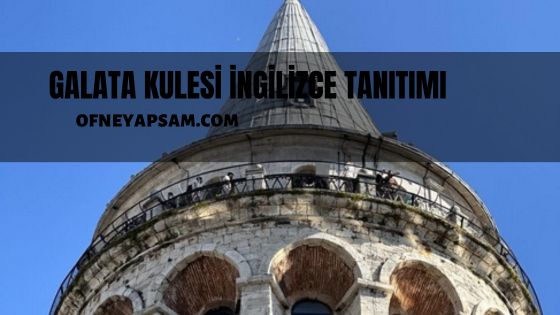Bu yazımızda Galata Kulesi İngilizce (Türkçe) Tanıtımını yapacağız.
Galata Kulesi İngilizce (Türkçe) Tanıtımı
Dünyanın en eski kulelerinden biri olan Galata Kulesi Bizans İmparatoru Anastasius Oilozus tarafından 528 yılında fener kulesi olarak ahşaptan inşa ettirilmiş,1348 yılında Cenevizliler tarafından Christea Turris(İsa Kulesi) adıyla yığma taştan yeniden yapılmıştır. 1453’te Fatih Sultan Mehmet’in İstanbul’u fethiyle birlikte Osmanlı İmparatorluğu’nun yönetimine geçen Galata Kulesi imparatorluğun en parlak ve en bunalımlı dönemlerine tanıklık etmiştir. II.Bayezid’in hükümdarlığı zamanında yaşanan büyük depremde hasar gören kule 1510 yılında Mimar Murad Bin Hayreddin tarafından onarılmıştır. Daha önceleri savunma amacıyla kullanılan Galata Kulesi müneccim Takiyıddin tarafından bir rasathane olarak kullanılmıştır. Bu rasathane 1579’da kapatılmış ve kule Kasımpaşa tersanelerinde çalıştırılan ve forsa adı verilen savaş esiri hristiyanların barınağı olmuştur.
Galata Tower,one of the oldest towers of the world was built of wood by byzantine emperor Anastasius Oilozus in 528 as a lighthouse, in 1348 it was recontructed by the Genoese as Christea Turris(Christ Tower) using stack stone.Galata Tower was owned by the Ottoman Empire during the conquest of Istanbul in 1453 by Sultan Mehmet II ”The Conqueror” and witnesses the most brilliant and the most troublesome era of the empire.During the reign of Bayezid II the Tower was devastated by an earthquake and it was repaired by the Turkish architect Murad Bin Hayreddin. The tower which was used for defense purposes mainly started to be used as and astronomical observation point by the Turkish astronomer Takiuddin.The observatory was closed in 1579 and the tower was used to house ”forsa” which stands for Christian prisoners of war who were usually worked as slaves in the Ottoman dockyard at Kasımpaşa at the Golden Horn.
IV. Murat (1612-1640) zamanında Hezarfen Ahmet Çelebi hazırladığı kanatlarla,tarihteki ilk uçuşu gerçekleştirmiştir. Galata Kulesi’nden havalanan Hezarfen Ahmet Çelebi İstanbul Boğazı’nın karşı kıyısında, yaklaşık 6 kilometre uzaktaki Üsküdar semtine dek uçmayı başarmıştır. Padişah tarafından ödüllendirilen bilim adamı, daha sonra tehlikeli bulunarak Cezayir’e sürülmüştür.1714 yılında itfaiye teşkilatının kurulmasıyla, Galata Kulesi’ne yepyeni bir görev verilmiştir. Kuleye yerleştirilen gözcüler şehirde çıkan yangınları gözleyerek İstanbul’u tehdit eden bu sinsi düşman ile amansız bir mücadeleye girişmiştir. Ancak 1794’te,yıllarca tüm şehri uyardığı yangınlardan birinin kurbanı olmuştur. Kulenin kurşun ve ahşaptan oluşan çatısı, odalar ve merdivenler tamamen yanmıştır.1831 yılında geçirdiği bir başka yangında kule büyük hasar görmüştür. Bu dönemdeki onarımla Galata Kulesi’ne yeni bir kurşun külah giydirilmiştir.
During the reign of Murad IV (1612-1640),Hezarfen Ahmet Çelebi flew as an early aviator using artificial wings from this tower over the Bosphorus to the slopes of Üsküdar on the Anatolian side nearly 6 kilometers away.Sultan Murat IV was delighted and wanted to award Hezarfen but then changed his mind. Hezarfen was exiled to Algeria for being considered as a thereat. By the time The Fire Brigade Organization was founded in 1714,the tower has been assigned a new task. The watchmen located on the tower watched for fires in order to struggle against the insidious enemy thereating Istanbul. Ironically the tower became a victim of one of those fires which was used to alter the city for many years. The tower’s roof which was made of lead and wood, its rooms and stairs were completely destroyed by the great fire in 1794.Another fire in 1831 caused drastic damages and the tower’s conical cap was replaced in the restoraiton.
Galata Kulesi’nin görünümü tarih boyunca bir çok değişikliğe uğramıştır. Bu değişikliklerden en büyüğü 1864 yılındaki imar çalışmalarında yaşanmıştır. Kulenin avlusu ve kıyıya inen sur duvarları yıkılmış çevresindeki hendekler de doldurulmuştur. Galata Kulesi 1967 yılında 3 yıllık bir restorasyonun ardından, II.Mahmut dönemindeki görüntüsüne kavuşmuştur.
The Galata Tower’s silhouute had changed many times in the past and was reconstructed on a number of occasions in the Ottoman period, most notably in 1864 during the public improvements. The tower’s court and ramparts descending to the shore were demolished and the surroundging trenches were filled. The tower was closed for restoraion for 3 years and reopened in 1967. During this period of time,the tower had been restored to its former appearance as it had been in Mahmut II period.
Galata Kulesi’nin iç çapı zemin katında 8,95, dış çapı 16,45 metredir. Duvar kalınlığı temelde 3,75 metre, en üst katta ise 20 santimetredir.4.kattan sonra, Osmanlı çağı yapımı olduğunu gösteren biçimde mazgallar ve 5.katta top namlularının yerleştirildiği yuvalar vardır. Kulenin yüksekliği 66.90 metredir. 7. ve 8. katların her birinde 14 pencere yer almaktadır. Galata Kulesi dünyanın ziyaretçi kabul eden en eski kulesidir. Bugün bile İstanbul’un en yüksek yapılarından biridir. Tüm ihtişamıyla şehrin üzerinde yükselmekte, İstanbul’un tarihine tanıklık etmeye devam etmektedir.
The external diameter of the tower at its base is 16.45 meters, the inside diameter is 8.95 meters.The thickness of the walls at its base is 3.75 meters and at the uppermost floor it diminishes to 20 centimeters.Between the fourth floor and the uppermost floor there are slits made in Ottoman age.On the fifth floor there are holes where hung barrels are located.The tower’s altitude is 66.90 meters.On each of seventh and eighth floor there are 14 windows.Galata Tower is one of the greatest buildings of Istanbul and the oldest tower in the world which had been opened for visitation.It still rises above the city with its splendour and witnesses the history of Istanbul.



